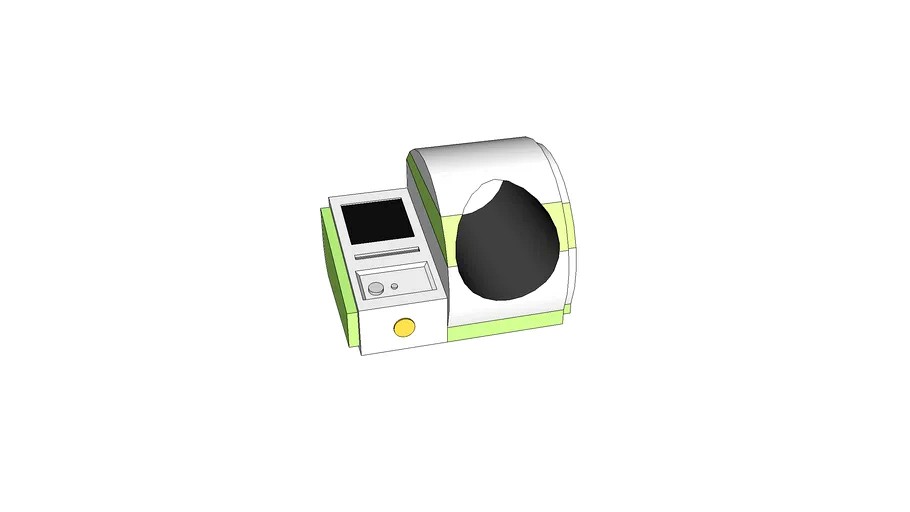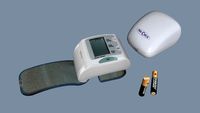3DWarehouse

Sphygmomanometer
by 3DWarehouse
Last crawled date: 10 months, 1 week ago
The sphygmomanometer (or sphygmometer or sphygmoscope, pressure gauge) is a biomedical device used for measuring arterial pressure invented at the end of the nineteenth century, whose unit of measure is the millimeter of mercury (mmHg). The name derives from the combination of the Greek word sphygmòs, pulsation, pulse and pressure gauge (in turn composed by the Greek manòs, rare and métron, measure). The device was invented by the famous Neapolitan chemist Pietro Pulli (1771-1842) (C. Minieri-Riccio, Historical Memories of those born in the Kingdom of Naples, 1844) and according to some by Samuel Siegfried Karl Ritter von Basch in 1881. In 1896 Scipione Riva -Rocci introduced an improved version that was easier to use. Nikolai Sergeevič Korotkov perfected the measurement by identifying audible sounds in the brachial artery during deflation of the cuff. Harvey Cushing met this instrument in 1901, going to Pavia to learn the use of clinical sphygmomanometry and introduced it in the United States, bringing a lowering of operative mortality from anesthesia. Since knowledge of a patient's blood pressure is significant and since diseases such as hypertension are widespread in the Western world, it is critical that staff are trained to use this tool to ensure maximum accuracy. House sphygmomanometers, now mostly electronic, are only used to perform a routine check. #Sphygmomanometer
Similar models
3dwarehouse
free

Electronic sphygmomanometer
... #hopital #hospital #instrument #measure #medical #medicine #médecine #pressure #santé #sphygmomanometer #tensiomètre #équipement
cg_trader
$15

Pressure gauge ball valve 3 8 in | 3D
...e pump plumbing refinery sink mixer processing coupling mechanical axle transition hose pressure gauge ballvalve miniatures other
grabcad
free

Pressure Gauge
...pressure gauge
grabcad
it is used to measure pressure are called pressure gauges or vacuum gauges.
grabcad
free

Bourdon tube pressure gauge
...bourdon tube pressure gauge
grabcad
bourdon tube pressure gauges are used for the measurement of gauge pressures.
grabcad
free

Pressure Gauge
...pressure gauge
grabcad
pressure gauge used to measure the value of pressure in various machines
grabcad
free

Pressure Gauge
...pressure gauge
grabcad
this tool is used to measure water pressure and air pressure
3dwarehouse
free

3 inch pressure gauge
...3 inch pressure gauge
3dwarehouse
gauge for measuring air pressure, 3 inch diameter. #gauge #measure #mechanical #pressure
grabcad
free

pressure gauge
...d
this is a shell of pressure gauge. it used for measuring gas or every fluid pressure . and it produced by tech sis corporation
cg_trader
$25

pressure gauge
...rd party plugins used
this is available as a low poly model in blender alone (subdivision not applied)
this model is uv unwrapped
grabcad
free

Pressure measuring device
...pressure measuring device
grabcad
pressure measuring device
Sphygmomanometer
turbosquid
free

Sphygmomanometer
... available on turbo squid, the world's leading provider of digital 3d models for visualization, films, television, and games.
turbosquid
free

sphygmomanometer
... available on turbo squid, the world's leading provider of digital 3d models for visualization, films, television, and games.
3d_export
$5

blood pressure monitor
...blood pressure monitor 3dexport ' sphygmomanometer ' is a full 3d model to add more...
thingiverse
free

3V air pump holder by JanuszDrukowania
...simple holder for 3v chinese air pump from aliexpress (https://www.aliexpress.com/item/3v-transparent-pump-head-032-air-pump-motor-for-teaching-experiment-sphygmomanometerhgoxygenation-pump-130ma-300mm/32721639380.html?spm=2114.13010608.0.0.oglxji) it's designed for friction fit, but it can also...
renderosity
$70

Doctor's House Call Medical Collection
...medicine vial, nerve stimulator, otoscope, reflex hammer, scalpel, scissors, sphygmomanometer (blood pressure cuff), stethoscope, digital thermometer, tongue depressor, tuning...
cg_trader
$29

Sphygmomanometer
...g trader
3d model hypertension sphygmomanometer sphygmomanometer, formats max, obj, mtl, 3ds, fbx, ready for 3d animation and ot
grabcad
free

Sphygmomanometer mechanism.
...sphygmomanometer mechanism.
grabcad
sphygmomanometer mechanism, under the loupe.
grabcad
free

Tansiyon Aleti - Sphygmomanometer
...tansiyon aleti - sphygmomanometer
grabcad
not detailed design.
grabcad
free

sphygmomanometer
...abling the determination of systolic and diastolic blood pressure by increasing and gradually releasing the pressure in the cuff.
cg_trader
$20

Sphygmomanometer 3D model
...al manometer stethoscope cardiology health hypertension medical instrument equipment medicine heart tool hospital patient anatomy
